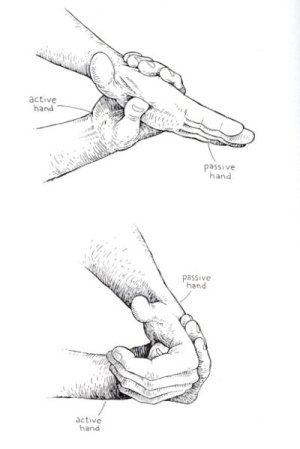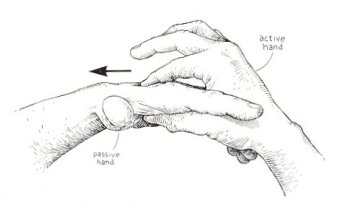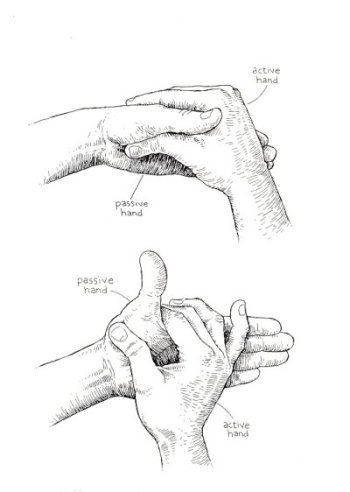Here's the Rub
Self massaging your way to healthy tendons
By Amy Ratto (from Climbing Magazine, Issue #183, March
1999)
"I am a believer!" said Michelle Hurni, hard sport climber and president of the
America Sport Climbing Federation, about her massage experience. "I had elbow
tendinitis once and got rid of it by myself, just by massaging." When she told
a friend at the climbing gym of her cure, he said it would never work on his
four-year-old case of tendinitis. "I showed him how to do it and when I saw
him a month later he wanted to kiss my feet!"
Most people don't realize the role massage can play in the prevention and
healing of injuries. "I feel like one of the reasons I haven't been injured
more is because I take care of it ahead of time," says Hurni. She gets a
professional, full-body massage at least once a month, but massages her hands
every night, and sometimes several times a day.
You might think that tweaked fingers and elbow tendinitis are a sad part of
every climber's life, but they don't need to be. Most climbing injuries develop
over a period of time, and massaging regularly helps alert you to red flags for
future injuries. "Sometimes your hands don't feel painful when you climb," she
says, "but if something hurts when you touch it- then you know you had better
massage it before it gets bad."
Massage is one of the most basic forms of therapy around. It's been used since
the Greeks and Romans hung out in public baths, and its popularity is on the
rise. Some therapy programs have had such consistent results that some
insurance companies are willing to pay for them. Besides, self-massage is
cheap, it's easy, and it feels good.
The exercises in this article focus on injury prevention. If you are already
injured, consult a professional therapist for a massage plan. If an injury is
not massaged correctly it can actually be made worse for all your effort.
Massage Moves Blood
Massage involves any manipulation of the skin and muscular tissues. It helps
blood flow and can cause changes in the content of the blood. According to
Elliot Greene, former president of the American Massage Therapy Association,
the oxygen capacity of the blood can increase 10 to 15 percent after massage;
muscle efficiency increases with more oxygen in the blood. Massage helps relax
irritated, contracted muscles, and when combined with rest, is known to speed
muscle recovery by 25 to 100 percent. It also flushes out toxins such as
lactic or carbonic acids, which can cause adhesions in the muscle fibers that
limit flexibility and range of motion.
Breaking The Tendinitis Cycle
Tendinitis is a chronic condition cause by overuse. It can cause mild to
intense pain, and, if untreated, can ground you for a long time. Most
climbers suffer tendinitis in their fingers and elbows because the tendons
there are so small and easily irritated. But it doesn't happen overnight. Says
Melynda Candee, a certified massage therapist in Colorado who has worked with
many climbers. "The key to preventing tendinitis is to stop the tension at the
beginning."
Muscles attach to tendons and tendons attach to bones at connectors. As you
climb, muscles and tendons work together to move your fingers, wrists, and
elbows. After a day of climbing, these tendons and muscles are
fatigued. Without stretching or massage, the muscles remain tight and flexed,
even when relaxed (remember the saying "Don't make that face or it will get
stuck?" Your muscles really can freeze over a long period of specific
use). This tension in the belly (or thickest part) of the muscle creates a pull
at the connector of the tendon; for climbers, tension in the biceps, triceps
and forearms result in irritation of the connectors in the elbow. This pull
causes the irritation and inflammation that may eventually build into
tendonitis (for more information about tendonidis, see Climbing No. 169, "A
Sore Subject).
When you stretch and massage your muscles and tendons after climbing, the
connectors are releaxed at the end of each day and the tension doesn't have a
chance to build.
How It Works
Massage is more than finding the sore spots and rubbing hard. The purpose and
effects of massage will differ, but the most important thing about pre-climbing
massage is simply that you do it. Getting on the rock cold is the worst thing
you can do for you muscles and tendons. Massaging prior to exercise
invigorates the muscles and prepares them to work. Says Candee, "The massage
should be gentle and quick. Focus on warming general areas and never use deep
pressure." (for pre-climbing massage use on light version of techniques 1 and
6-10 below).
Massaging after climbing helps release the accumulated muscle wastes that later
cause cramping and sore muscles. The rush of blood from massage also feeds the
tissues and encourages even the smallest injuries to heal at a faster rate. But
right after coming down from a climb it is more important to stretch the
muscles than it is to massage them. Stretching everything from your fingers to
your back loosens the flexed muscles while the blood is still pumping through
them, and gives you a jump on the recovery process. Only after you are
competely cooled down will you want to begin the real massage.
Basic Principles
- "No pain, no gain" does not apply. Says Candee, "On a scale from 1 to 10,
you should try to keep yourself in the five or six zone at all times." This is
the "pleasure-pain" threshhold, where it will hurt, but your muscles will not
clench protectively.
- Begin gently and warm up the area before you begin. Aggressive massage
right away can injure even healthy muscles and tendons.
- Relax the arm to be massaged (hereafter referred to as the "passive" arm,
while the massaging hand is the "active" hand). If the muscles are not relaxed
you might as well not waste your time.
- Find a good pace. Your active hand is likely to get tired. Although it is
very important to do the techniques in the given order, rotate from arm to arm
as often as you like.
- Do some of everything; don't leave out your hand because your elbow
hurts. The tendons that connect at the elbow meet the muscle, then continue
across your wrist, all the way down to your finger tips. Tension in any part
of the system puts a straing on the connector, so the whole tendon has to be
treated, not just the place where you feel pain.
Ahhh, There's The Rub
Forearms
- Friction Rub With an open palm, rub lightly and quickly
along the inside of your forearm. Your skin will begin to turn pink when it
has been heated up. (1 minute)
- Wrists Hold your passive hand in front of you and turn
your palm up toward you. Place your active hand underneath it, also
palm facing you, index finger just above the knuckles, your thumb at
the base or center of your palm. Use your active thumb as a stationary
pivot point, while you begin to curl your passive fingers and wrist,
until your fingers are wrapped around your thumb (figure 1).
 |
| Figure 1. Wrists |
At the
same time, use active fingers to rub down the back of your hand, clear
past the wrist. It will feel as though you are pulling on skin more
than anything. (2 minutes)
- Knuckle Friction Similar to the Friction Rub,
this technique works the muscles more deeply. Press the knuckles of
your active hand into the underside of your passive wrist. Move slowly
and deeply up the length of your forearm. (2 minute)
- Thumb Press Move the ball of your thumb very
slowly up the length of your arm toward the elbow. Feel for painful
places in the tendons. Follow a number of different lines in the
forearm unti you have covered the whole width of your arm. (3 minutes)
- Cross-fiber Frictioning The deepest and most
injury specific technique of all. Locate a painful or rough place in
the muscle. With your fingertips, begin a slow downward pressure and
the push the tendon to one side. You will feel a small pop as you
move across the tendon. Important: only friction in one
direction. Popping the tendon back and forth can create an injury. (4 minutes)
Hands
- Finger-tip Circles Pinch a passive-hand finger
tip between your active thumb and index finger. Rub the underside of
the finger in a circular motion. Remember your thumbs. (30 seconds)
- Finger PinchesWith the side of your active index
finger and the ball of your active thumb, pinch the soft skin on the
underside of the finger and move it side to side; at the tip, which
has less padding, pinch the sides. (1 minute)
- Spreaders Place your active index finger in
between the first and second knuckles on the top of your hand,
pointing toward your elbow. With your thumb firmly planted in the
palm of your hand, very slowly and gently press down on the space
between the knuckles, as if your were trying to separate the bones in
your hand (figure 2).
 |
| Figure 2. Spreaders |
 |
| Figure 3. Thumb Sweep |
Work toward your wrist and stop there. Work
between each pair (second and third, third and fourth) of knuckles the
same way. (1 minute)
- Pinky Pinch Grab the muscle directly below your
pinky finger between your thumb and side of your bent index finger.
Pull and pinch gently as you move up and down the muscle. (1 minute)
- Thumb Sweep Start by placing your active thumb
at the base of your palm, directly below the middle finger and
pointing at your elbow. Your active fingers should be against the back
of your passive hand (figure 3). Using the ball of your thumb, begin
to apply pressure while slowly sweeping your active thumb across the
passive thumb muscle in a clockwise direction, all the way up the
passive thumb. (1 minute)
Cool Down
Finally, work backward to cool down. You don't need to reverse the
whole cycle, but do some lighter techniques to help the muscle retreat
to a resting state.
All together the entire post-climbing massage should only take 10 to
15 minutes, depending on how long you focus on certain areas, but it
can save your hands and elbows for routes and routes to come.
Amy Ratto is an intern at Climbing. She climbs as much as possible
and preaches the wonders of self-massage to anyone who will
listen.




